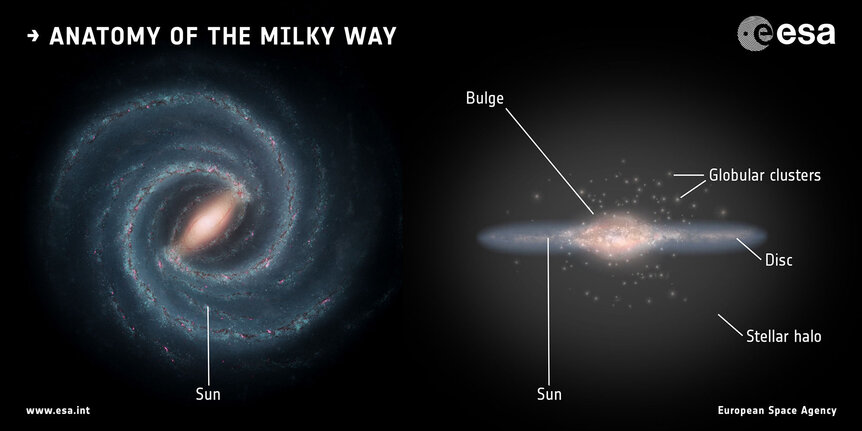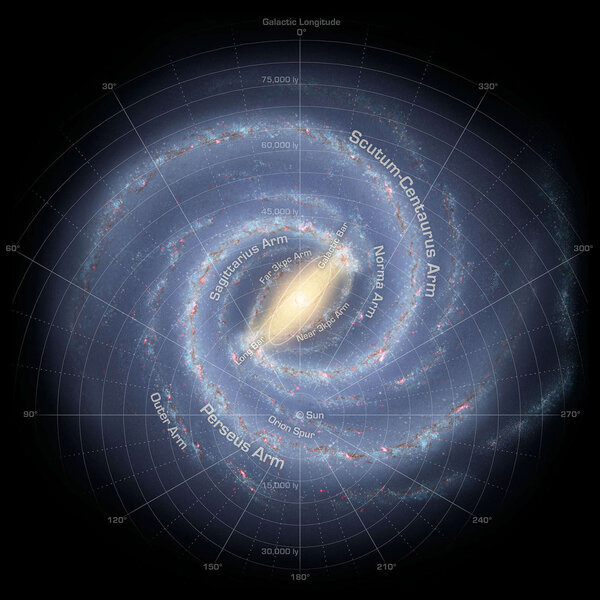Create a free profile to get unlimited access to exclusive videos, sweepstakes, and more!
Our Milky Way galaxy’s last big collision still leaves clues 10 billion years later
Undigested cosmic sausage reveals secrets of a massive galactic merger.

Our Milky Way galaxy is huge, 120,000 light years across its flat disk, and two million light years across its immense halo, a cloud of stars surrounding the disk in a vaguely squashed spherical shape.
But it wasn’t born that way. Instead, it grew via cannibalism.
Yes, galaxies eat other galaxies. Or, less colloquially and more accurately, they collide and merge. If one galaxy is larger than the other, the smaller becomes a part of the bigger, subsumed and coalescing with it, the two nearly indistinguishable after an eon or two.
Nearly. The most recent large merger the Milky Way underwent occurred roughly 10 billion years ago, and we know this because we can see the last undigested bits of that galaxy orbiting inside ours. This was discovered in 2018 when astronomers were looking at orbits of stars using data from the Gaia mission, which measured the positions, motions, and distances of over a billion stars in the Milky Way. When plotted a certain way — their radial versus azimuthal velocities, that is, their motion toward and away from the galactic center versus their velocity around it — a group of stars formed a vaguely sausage-like shape, indicting they all had the same source. The structure is called the Gaia Sausage, and the galaxy Gaia-Enceladus (after one of the daughters of the goddess Gaia in mythology).
Naturally, astronomers want to know as much about this galaxy and its collision with our own. How long ago did it happen? How long did it take? How big was the galaxy, and what was the collision like?
A team of astronomers may have some answers. They created a series of simulations of collisions between the Milky Way and Gaia-Enceladus, seeing which ones matched the data the best (link to paper). The results wind up not only giving insight on the collision, but also appear to explain quite a bit of the structure of our galaxy as we see it today.
The data they used came from the H3 Stellar Spectroscopic Survey, which used the massive 6.5-meter MMT telescope in Arizona. It’s mapping the positions and velocities of 200,000 – 300,000 stars that are located in the Milky Way’s disk and halo, from 10,000 to over 300,000 light years from the galactic center. This alone is an amazing achievement, since these stars are faint and some very far away. But by doing this, the dynamics of these stars can be found — measuring their motions reveals their history, including how they were affected by the collision.
The scientists made what are called n-body simulations — modeling a galaxy as a collection of self-gravitating points that simulate stars, dark matter, and their structure — where they could vary things like the mass of each galaxy, the direction the Gaia-Enceladus galaxy came in, its velocity, and more. They then change the parameters a little bit and rerun the sims, doing this over and again to see what comes out.
In the end, the best fit they found to the H3 data was for an incoming galaxy with 500 million times the Sun’s mass worth of stars and 200 billion solar masses in total, including dark matter. For comparison, the Milky Way has a mass of 700 billion suns, so it was over three times more massive than the intruder. Still, this was a big collision.
Their best fit indicates the Gaia-Enceladus galaxy came in from a direction where it hit the Milky Way retrograde, in the opposite sense of our galaxy disk’s rotation, making this a head-on collision. Stars left over from the original intruder galaxy still orbit ours “backwards.” Its disk spun opposite ours as well. It came in at a low angle, about 15° from the plane of the Milky Way’s disk on what was essentially a highly elliptical orbital path. It passed the Milky Way’s center, started to be torn apart as it pulled away, then fell back in. The stream of stars from the now-disrupted intruder would then take another long path into and away from the Milky Way’s center.
Stars from the outer part of its disk were stripped away first by the Milky Way’s stronger gravity. The inner halo of the Milky Way was strongly affected by this event. Instead of being a spherical cloud of stars surrounding our galaxy, it’s what’s called a triaxial ellipsoid, a bit like a slightly squashed egg. Its long axis is tipped by 35° to the Milky Way’s disk.
That immediately explains something interesting. When an object is on an elliptical orbit around another object, it moves more rapidly when it’s close and more slowly when it’s far away. If you have a lot of objects on that same orbit they’ll tend to pile up when they are at the apocenter, the most distant part of their orbit.
The fun part is that there are two overdense places in our galaxy where more stars than average are in a small volume. These are named the Hercules-Aquila Cloud and the Virgo Overdensity, after the constellations in which they are seen. The simulations wind up modeling them well: These are where stars from the Gaia-Enceladus galaxy have piled up at two apocenters, one from its first pass and the other from its second and final pass through the Milky Way. That’s a pretty cool outcome of the simulations, and shows that the astronomers are on the right track.
They also found other, more subtle results as well, including being able to match the ages of the stars observed in the Milky Way left over from the collision to the timing of the collision. It would’ve started roughly 10 billion years ago and lasted for 2 billion, by which point the majority of Gaia-Enceladus had been ingested. They also find that the collision supplied about 20% of the dark matter now in our galaxy’s halo, and a respectable 50% of its stars.
What I like is that they make predictions as well, things that can be tested eventually via observation. For example if they are correct they expect to see two sudden drop-offs of stellar density in the halo, one about 50,000 and the other about 100,000 light years from the Milky Way’s center, due to the gravity of Gaia-Enceladus disturbing Milky Way stars when it piled up at the two apocenters mentioned above. They also predict the outer halo 100,000 light years out should have about 10% of the intruder galaxy mass moving backwards in a stream.
These predictions are a wee bit tough to observe right now, but as time goes on we’ll have deeper surveys of these stars, so we’ll see.
I find all this equal parts fascinating and amazing. The science of this, knowing that our galaxy grew by collisions, is enthralling. But just as cool is being able to simulate this, applying incredibly complex physics and actually seeing the galactic structures thousands of light years across popping up in those simulations, looking very much like what is actually observed. That’s staggering.
We can look up into deep space and not only understand what we see but actually understand how it got that way as well. On a literally galactic scale.
Science! I love this stuff.





























